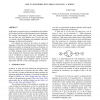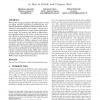26354 search results - page 59 / 5271 » How we refactor, and how we know it |
WSC
2007
13 years 11 months ago
2007
In this paper we present a survey on methods for the synthesis of Petri nets from behavioral descriptions given as languages. We consider place/transition Petri nets, elementary P...
CONEXT
2008
ACM
13 years 10 months ago
2008
ACM
Motivated by emerging cooperative P2P applications we study new uplink allocation algorithms for substituting the ratebased choke/unchoke algorithm of BitTorrent which was develop...
GRID
2006
Springer
13 years 9 months ago
2006
Springer
The Grid computing vision promises to provide the needed platform for a new and more demanding range of applications. For this promise to become true, a number of hurdles, includin...
CORR
2007
Springer
13 years 9 months ago
2007
Springer
— In this paper, a downlink communication system, in which a Base Station (BS) equipped with M antennas communicates with N users each equipped with K receive antennas is conside...
JUCS
2002
13 years 8 months ago
2002
: We consider disjunctive sequences, that is, infinite sequences (-words) having all finite words as infixes. It is shown that the set of all disjunctive sequences can be described...


